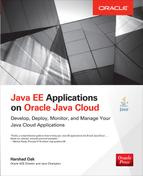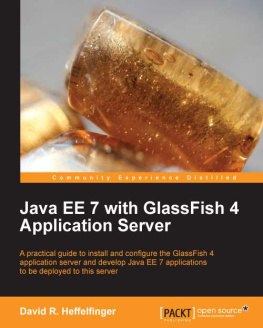Praise for
The JAVA EE
Architects Handbook
Derek Ashmore has assembled a must have book for anyone working with Java and/or Java EE applications. Mr. Ashmore covers all the bases in this how to approach to designing/developing/testing/and implementing Java EE applications using Java with frequent references to XML, JDBC libraries, SOAP, relational database access (using SQL), and references various useful tools when relevant. This book clearly illustrates Dereks expertise in the Java world.... Thank you for sharing your knowledge with the IT community with such a useful book.
Dan Hotka, Author/Instructor/Oracle Expert
This book is very well crafted and explains everything you really need to know in order to be a successful and productive Java EE architect. It is an excellent book, which offers a full and detailed coverage of the topic of Java EE architecture and can be used as a handbook by the novice or as a reference tool for the experienced architect. The straightforward writing style and good visuals make for a quick and comprehensive learning experience. If Java is your primary programming language, and youre currently working as a Java EE architect or considering it as a future career, this book should be in your library.
Ian Ellis, Vice President and Chief Information Officer, IESAbroad
[Derek has written] an in-depth and comprehensive resource for the Java2 architect! The book provides a concise road map for real-world Java EE development. The approach is practical and straightforward, based on a wealth of experience. All aspects of project management, application and data design, and Java development are covered. This book avoids the dry style and over-abstraction (over-simplification) common to so many books in this subject area. An awesome book, I keep it on my A shelf!
Jim Elliott, CTO, West Haven Systems, Inc.
Clear reading and bridges the gap between professionals and professors. Ive read many technical books in my thirty-year career where the author spends more time tossing around the current buzzwords and fails to get the point across. Dereks book really connects with the hard core developer. Practical, knowledgeable, excellent examples.
John R Mull, President, Systech Software Products, Inc.

2014 by Derek C. Ashmore. All rights reserved.
Editor: Cathy Reed
Cover Design: The Roberts Group
Interior Design: The Roberts Group
Indexer: The Roberts Group

Published by:
DVT Press
Bolingbrook, IL
sales@dvtpress.com
http://www.dvtpress.com
All rights reserved. No part of this book may be reproduced or transmitted in any form or by any means, electronic or mechanical, including photocopying, recording or by any information storage and retrieval system, without written permission from the author, except for the inclusion of brief quotations for a review.
The opinions and views expressed in this book are solely that of the author. This book does not necessarily represent the opinions and views of the technical reviewers or the firms that employ them.
TRADEMARKS: Java, Java EE, Java Development Kit are trademarks of Oracle Corporation, Inc. All other products or services mentioned in this book are the trademarks or service marks of their respective companies and organizations.
While every precaution has been taken in the preparation of this book, the author and publisher assume no responsibility for errors and omissions or for damages resulting from the use of the information contained herein.
Contents
Preface
T he Java EE Architects Handbook was written for application architects and senior developers tasked with designing and leading the development of Java EE applications. The objective of this book is to help you fulfill the application architect role in a Java EE project. If you are a senior developer needing to fill the role of an application architect for the first time, this book will help you succeed. If you are already an application architect, this book will empower you with additional skills so that you can improve your ability to fulfill that role. This book provides numerous strategies, guidelines, tips, tricks, and best practices to help the junior architect navigate the entire development process, from analysis through application deployment and support. To help you achieve success as a Java EE application architect, the book presents the following material:
- A basic framework for filling the role of application architect at every stage of the project life cycle
- Architect-level tips, tricks, and best practices at each stage of development
- Tips, tricks, and best practices for establishing coding standards to make code consistent and more maintainable
- Tips, tricks, and best practices for creating and communicating designs
- Estimation and project-planning material
This edition of the handbook concentrates on application architect deliverables at each stage of development. That is, the book describes discrete tasks typically performed by the application architect and provides tips and techniques for performing these tasks. As many learn best by example, this book will provide examples of your deliverables.
Readers of the first edition might be confused by the title change for the second edition. The first edition of the book was titled The J2EE Architects Handbook. The term J2EE was deprecated in 2006 and replaced with the term Java Enterprise Edition or Java EE for short. Essentially, both terms refer to the same platform.
This book will not teach you how to program Java EE applications. While most application architects do code parts of the applications they support, they do so in their capacity of a developer, not in their capacity of application architect. The marketplace is replete with technical books that provide instruction on how to code Java EE applications. This book will complement, but not attempt to duplicate, that material. While there is sample code in the book, its purpose is to illustrate application architecture concepts; not to be a detailed instructional guide on how to write code.
This book is not a study guide for any of the certification exams for Java and Java EE technologies provided by the Oracle Corporation. Those exams concentrate purely on technical skills. While technical skills are necessary to be an effective application architect, they are not sufficient. The role of application architect transcends raw technical ability. Architects must be effective communicators, must work well with other team members, and must be able to understand the business aspects and requirements for the end user areas their applications support. None of these facets of being an effective application architect is measured by any of the certification exams.
Furthermore, the book is not for beginners. Readers should know Java syntax and basic Java EE concepts and have at least an intermediate programming skill set and basic experience with the following:
- Relational databases, SQL, JDBC, and a JPA implementation such as Hibernate
- JSPs, servlets, and experience with at least one web framework (e.g., Spring-MVC, Struts, Java Server Faces)
- Experience working with what are commonly open source projects such as Apache Commons, Spring, Hibernate, and many more
- Experience working with a development team





![Fu Cheng [Fu Cheng] - Exploring Java 9: Build Modularized Applications in Java](/uploads/posts/book/119397/thumbs/fu-cheng-fu-cheng-exploring-java-9-build.jpg)
![Vishal Layka [Vishal Layka] - Learn Java for Web Development: Modern Java Web Development](/uploads/posts/book/119395/thumbs/vishal-layka-vishal-layka-learn-java-for-web.jpg)
![Ram Kulkarni [Ram Kulkarni] - Java EE 8 Development with Eclipse](/uploads/posts/book/119355/thumbs/ram-kulkarni-ram-kulkarni-java-ee-8-development.jpg)





